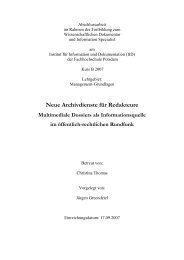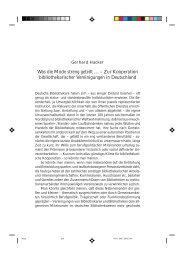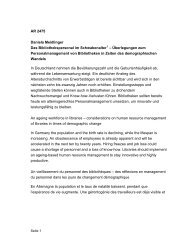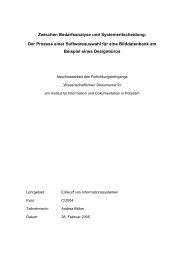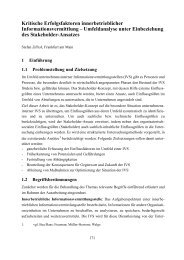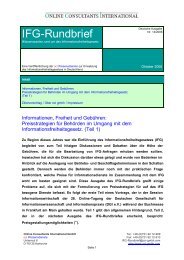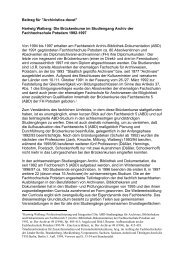PDF(886K) - Wiley Online Library
PDF(886K) - Wiley Online Library
PDF(886K) - Wiley Online Library
Create successful ePaper yourself
Turn your PDF publications into a flip-book with our unique Google optimized e-Paper software.
2010c) or “units of knowledge” (Dahlberg, 1986, p. 10).<br />
A KOS is a concept system in a given knowledge domain. In<br />
knowledge representation, a concept is determined via words<br />
that carry the same, or at least a similar, meaning (this being<br />
the reason for the designation “Synset,” which stands for “set<br />
of synonyms,” periodically found for concepts) (Fellbaum,<br />
1998). In a first approach, and in unison with DIN 2342/1<br />
(1992, p. 3), synonymy is “the relation between designations<br />
that stand for the same concept.” There is a further<br />
variant of synonymy, which expresses the relation between<br />
two concepts, and which we will address below.<br />
Some examples for synonyms are autumn and fall or dead<br />
and deceased. A special case of synonymy is found in paraphrases,<br />
where an object is being described in a roundabout<br />
way. Sometimes it is necessary to work with paraphrases,<br />
if there is no name for the concept in question. In German,<br />
for example, there is a word for “no longer being hungry”<br />
(satt), but none for “no longer being thirsty” (Bertram, 2005,<br />
p. 41). This is an example for a concept without a concrete<br />
designation.<br />
Homonymy starts from designations; it is “the relation<br />
between matching designations for different concepts” (DIN<br />
2342/1, 1992, p. 3). An example for a homonym is Java. This<br />
word stands, among others, for the concepts Java (island),<br />
Java (coffee), and Java (programming language). In wordoriented<br />
retrieval systems, homonyms lead to big problems,<br />
as each homonymous—and thus polysemous—word form<br />
must be disambiguated, either automatically or in a dialog<br />
between man and machine. Varieties of homonymy are<br />
homophony, where the ambiguity lies in the way the words<br />
sound (e.g., see and sea), and homography, where the spelling<br />
is the same but the meanings are different (e.g., lead the verb<br />
and lead the metal). Homophones play an important role in<br />
information systems that work with spoken language, homographs<br />
must be noted in systems for the processing of written<br />
texts.<br />
Many concepts have a meaning which can be understood<br />
completely without reference to other concepts, e.g., chair.<br />
Albert Menne (1980, p. 48) calls such complete concepts<br />
“categorematical.” In knowledge organization systems that<br />
are structured hierarchically, it is very possible that such a<br />
concept may occur on a certain hierarchical level:<br />
...with filter.<br />
This concept is syncategorematical; it is incomplete and<br />
requires other concepts in order to carry meaning (Menne,<br />
1980, p. 46). In hierarchical KOS, the syncategoremata are<br />
explained via their broader concepts. Only now does the<br />
meaning become clear:<br />
or<br />
Cigarette<br />
...with filter<br />
Chimney<br />
...with filter.<br />
One of the examples concerns a filter cigarette, the other a<br />
chimney with a (soot) filter. Such an explication may take<br />
the incorporation of several hierarchy levels. As such, it is<br />
highly impractical to enter syncategoremata on their own and<br />
without any addendums in a register, for example.<br />
Concepts are not given, like physical objects, but are<br />
actively derived from the world of objects via abstraction<br />
(Klaus, 1973, p. 214). The aspects of concept formation (in<br />
the sense of information science, not of psychology) are<br />
first and foremost clarified via definitions. In general, it can<br />
be noted that concept formation in the context of knowledge<br />
organization systems takes place in the area of tension<br />
between two contrary principles. An economical principle<br />
instructs us not to admit too many concepts into a KOS.<br />
If two concepts are more or less similar in terms of extension<br />
and intension, these will be regarded as one single<br />
“quasi-synonymous” concept. The principle of information<br />
content leads in the opposite direction. The more precise<br />
we are in distinguishing between intension and extension,<br />
the larger each individual concept’s information content will<br />
be. The concepts’ homogeneity and exactitude will draw the<br />
greatest profit from this. Lloyd K. Komatsu (1992, p. 501)<br />
illustrates this problematic situation (he uses “category” for<br />
“concept”):<br />
Thus, economy and informativeness trade off against each<br />
other. If categories are very general, there will be relatively<br />
few categories (increasing economy), but there will be few<br />
characteristics that one can assume different members of a<br />
category share (decreasing informativeness) and few occasions<br />
on which members of the category can be treated as<br />
identical. If categories are very specific, there will be relatively<br />
many categories (decreasing economy), but there will<br />
be many characteristics that one can assume different members<br />
of a category share (increasing informativeness) and<br />
many occasions on which members can be treated as identical.<br />
The solution for concept formation (Komatsu, 1992,<br />
p. 502, uses “categorization”) in KOS is a compromise:<br />
The basic level of categorization is the level of abstraction<br />
that represents the best compromise between number and<br />
informativeness of categories.<br />
According to the theory by Eleanor Rosch (Mervis &<br />
Rosch, 1981; Rosch, 1975a,b, 1983; Rosch & Mervis, 1975;<br />
Rosch, Mervis, Gray, Johnson, & Boyes-Braem, 1976), we<br />
must distinguish between three concept levels: the superordinate<br />
level, the basic level, and the subordinate level:<br />
Suppose that basic objects (e.g., chair, car) are the most inclusive<br />
level at which there are attributes common to all or most<br />
members of the category. Then total cue validities are maximized<br />
at that level of abstraction at which basic objects are<br />
categorized. That is, categories one level more abstract will<br />
be superordinate categories (e.g., furniture, vehicle) whose<br />
members share only a few attributes among each other. Categories<br />
below the basic level will be subordinate categories<br />
(e.g., kitchen chair, sports car) which are also bundles of predictable<br />
attributes and functions, but contain many attributes<br />
which overlap with other categories (for example, kitchen<br />
1954 JOURNAL OF THE AMERICAN SOCIETY FOR INFORMATION SCIENCE AND TECHNOLOGY—October 2010<br />
DOI: 10.1002/asi



